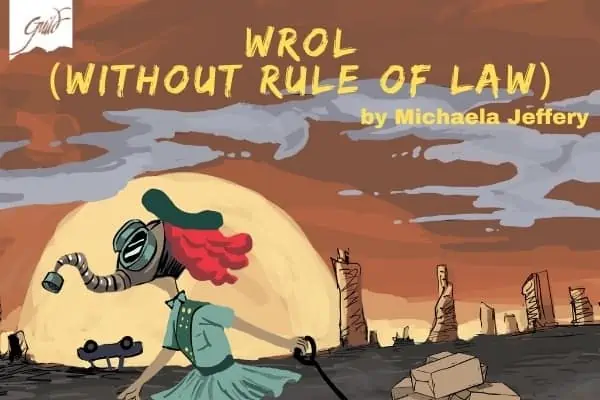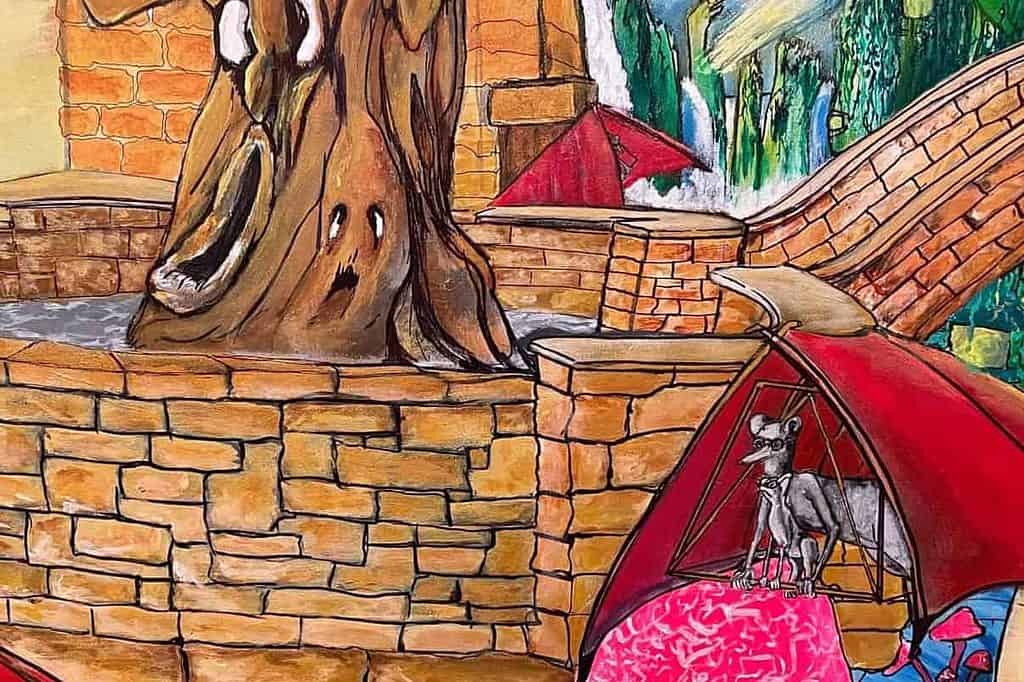Beyond Therapy
Jenna Walchuk has a story to tell.
Years ago, she was an addict. She’s been clean for many years, yet the need to go back to the emotions she remembers from that “time of such intellectual darkness” structures her art show, and her investigations in paint.
The story leads us around the Gallery 22 space, left to right. The first body of paintings incorporates collaged black and white images and image transfer, as well as printed collaged text, or what looks like Letraset. The words come from song lyrics.
On the tag next to each painting, Walchuk tells us part of her story of addiction. She remembers moments and emotions, chooses images and words to go with them, and uses paint and collage to express that moment.
You can imagine her sitting at her kitchen table, listening to music, remembering, and painting, trying to put it together.
Walchuk tells a story that’s easier to sweep under the rug.
“Living Underground” features a black and white image of the log skyscraper. It even has this paper’s logo on the front. The image must date to the time when What’s Up Yukon had its offices in the building.
The log skyscraper is a tourist icon. It’s a handy piece of downtown “local colour.”
In terms of colour, Walchuk has glazed the whole image orange. There’s no white left. It feels a little claustrophobic.
She’s collaged onto the canvas lyrics from Sarah Harmer’s “Basement Apartment” song, “watching TV all night underground…”
She’s also spattered the canvas with black paint, as well as stencilling a pattern reminiscent of wallpaper. The range in mark making between the controlled stencil marks and the random spatters adds to the visual interest of the piece.
In the tag beside the piece, she tells the story of her first overdose in the basement apartment of the log skyscraper. Suddenly the orange colour feels right.
Walchuk also uses a range of control in her marks to good effect in “Drowning”.
She’s used an image transfer process with acrylic medium to apply a black and white image to the canvas without the paper carrier used in collage.
It’s hard to tell what it is. It’s been made ragged and bumpy in the transfer process.
It was applied over a canvas prepared with blue, white and purple brushed horizontally.
Across the top, another wallpaper-style stencil block.
And up the side, in smeared text, “It’s a silly time to learn to swim when you start to drown./ It’s a silly time to learn to swim on the way down,” by Tegan and Sarah.
The text alongside explains how deeply that lyric resonates with Walchuk’s memories. The marks and words work together to express a moment of helplessness.
These are only a couple of images. We end in one called “Mirror, Mirror” right before the work changes.
An apt transition—the rest of the paintings in the show are inspired by the Rorschach test, where ink blots are shown to psychology patients who tell their therapists what the ink blots remind them of, to provide a glimpse into their minds.
Mirrored blots are created by applying paint loosely to one canvas, and then pressing them together, then separating them.
Walchuk has added colour, then named them with emotions—”Calm,” “Paranoia,” “Shame,” and so on.
She also tells us more short anecdotes on the tags beside each piece. Without the transferred images and texts, this part of the show seems more quiet and focussed.
Walchuk’s stated intention for the show is to encourage people to think of addictions as a health issue rather than as a moral issue.
It takes courage to tell this kind of story. Art is meant to be more than therapy. I believe that in shaping this material the way she has, Walchuk has spun this straw into something her viewers can use, and be inspired by.
The three and a half pages of comments in the comment book attest to this.
What she does is more than expression. Nothing in the life she left behind or even in the remembering of it requires her to shape it into this show.
This shaping is an act of joy and generosity, even as it delves into her darkest times for inspiration. And that joy is something we all do well to spend time with.
Walchuk credits a class with Emma Barr, and the “great interest, praise and encouragement” of her Whitehorse community for helping her get started with painting and keeping her going.
She calls herself an “emerging artist” and you can see that she’s fairly new to paint. This kind of free play and commitment to communicate through the medium is a great start.
Check out her Facebook page under “Kitchen Table Studio”. It will be great to see what she paints next.
Walchuk’s Drug Therapy exhibit continues at Gallery 22 above Triple J’s Music until June 16.


